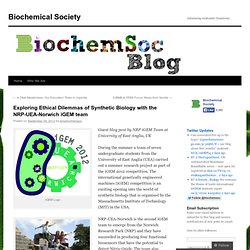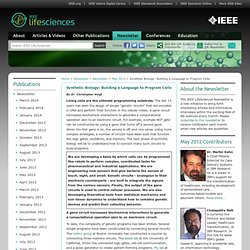

Global Synthetic Biology Market Forecasts and Opportunities, 2020. Designer Chromosome Shows The Promise Of Synthetic Biology. Synthetic Biology: The Next Frontier in Chiral Chemistry for API Synthesis. Research Groups and Projects. Each Media Lab faculty member and senior research scientist leads a research group that includes a number of graduate student researchers and often involves undergraduate researchers.

How new technologies can help people better communicate, understand, and respond to affective information. How technology can be used to enhance human physical capability. How to create new ways to capture and share visual information. How new strategies for architectural design, mobility systems, and networked intelligence can make possible dynamic, evolving places that respond to the complexities of life.
How to design, create, deploy, and assess tools and processes that foster civic participation and the flow of information between and within communities. MoMA: Design and the Elastic Mind: Nanodesign. BioBricks Foundation SB6.0: The Sixth International Meeting on Synthetic Biology. The biological microprocessor, or how to build a computer with biological parts. Untitled. CytoComp reinvents medical treatment - a revolutionary biological computer. Exploring Ethical Dilemmas of Synthetic Biology with the NRP-UEA-Norwich iGEM team.
iGEM Logo Guest blog post by NRP iGEM Team at University of East Anglia, UK During the summer a team of seven undergraduate students from the University of East Anglia (UEA) carried out a summer research project as part of the iGEM 2012 competition.

The international genetically engineered machines (iGEM) competition is an exciting opening into the world of synthetic biology that is organised by the Massachusetts Institute of Technology (MIT) in the USA. The NRP iGEM team NRP-UEA-Norwich is the second iGEM team to emerge from the Norwich Research Park (NRP) and they have succeeded in producing four functional biosensors that have the potential to detect Nitric Oxide. Cura is Quanticare’s revolutionary healthcare solution, a tattoo made of immortalised mammalian cells containing different bio sensors that have been specifically tailored to monitor and respond to changes in the body. The NRP iGEM team would like to thank the Biochemical Society for funding our concept video. Advisors: Dr. Untitled. 1006-synthetic-biology-dialogue. IV Synthetic Biology - KingsLinks - Central Wiki Service. Gerd Moe-Behrens - Google+ - Leukippos Institute Microbiome Engineering Today we might… Synthetic Biology: Building a Language to Program Cells - IEEE Life Sciences.
By Dr.

Christopher Voigt Living cells are the ultimate programming substrate. The last 15 years has seen the design of simple "genetic circuits" that are encoded in DNA and perform their function in the cellular milieu. A gene circuit harnesses biochemical interactions to generate a computational operation akin to an electronic circuit. Synthetic Biology Special Interest Group.
Synthetic Biology Engineering Research Center. SynBioFromLeukipposInstitute. Biochemist creates CO2-eating light that runs on algae. Our atmosphere is filling up with CO2 and we seem to be the major cause of that.

The generally accepted solution seems to be cutting back on emissions as quickly as possible, but implementing such cuts is problematic because everyone has to agree to do more, which essentially ends up costing a lot of time and money. There is an alternative to such measures, though. Instead of relying entirely on cutting emissions, why don’t we start taking CO2 out of the atmosphere? That’s exactly what biochemist Pierre Calleja is trying to do, and his solution almost sounds too good to be true. Calleja has developed a lighting system that requires no electricity for power. Certain types of algae can feed off of organic carbon as well as sunlight, and in the process produce carbohydrate energy for themselves as well as oxygen as a waste product. Cajella’s lamps consist of algae-filled water along with a light and battery system.
More at Earthtechling.
Journals. Reviews. Websites. iGEM. Institutions / Companies. Labs. PDFs. Software Tools. Videos. Papers. News.